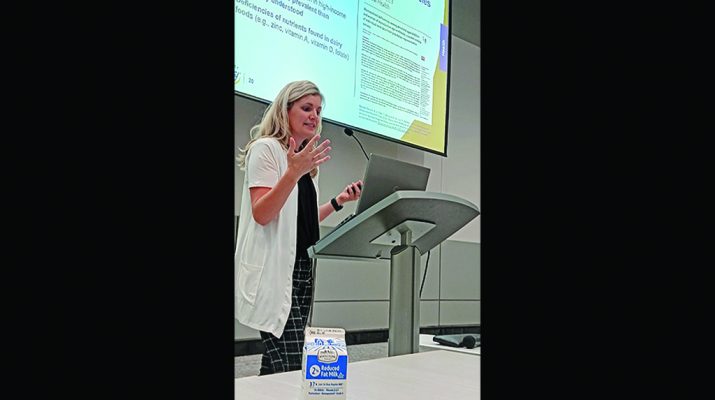Continental breakfast. A sophisticated-sounding name for convenient morning fare when you would rather spend a bit more time at the hotel than ask Google about places to eat nearby. Drinks are my highlight: refill the 20-ounce cup from the drive there with coffee, down at least two selections from the juice machine and snag a school cafeteria-size carton of milk from the mini fridge for later.
On the final morning of the recent Keep Nebraska Beautiful (KNB) conference in Omaha I passed on chocolate milk or strawberry and tossed a 2 percent in my day pack to drink while listening to the last speaker, still listed as “TBD” on the agenda. The speaker? Ashley Larson, a registered dietician with Midwest Dairy. She is based in Lincoln, though the organization is a non-profit that handles the dairy industry’s checkoff program for 10 states, including Nebraska.
Overall, dairies do their best to mitigate any negative impact on the environment like any other responsible contributor to American agriculture. Where my jug of milk comes from rarely crosses my mind unless I see a dairy on a road trip, and, living in beef country, when a news story talks about cows and methane I think of feedlots. The few head of dairy cattle our neighbors had when I was a kid are long gone.
Ashley explained that she has been learning as she goes after starting seven months ago. Her emphasis is to promote nutrition and dairy consumption. A University of Nebraska-Lincoln graduate, Ashley lived in Sidney previously where she served on the Keep Sidney Beautiful board of directors.
The industry she represents has consolidated while becoming more efficient in recent decades even though Nebraska still boasts 88 dairies. While driving for the first time between Kearney and Ansley on the way home from the conference, I passed Wood River Dairy. During 2023, the Nebraska Department of Agriculture opened its Ag and Economic Development Summit by hosting a tour there.
Showing a slide of the four domains in a food system – from farm to fork, Ashley focused on “environment”, which addresses the impact on natural resources: greenhouse gas (GHG) emissions; land use and soil quality; water usage and quality; and, resilience to extreme weather, climate change, resource degradation, and other forms of environmental stress.
Ashley addressed GHG, contrasting methane, which accounts for 11 percent and lasts 12 years in the atmosphere, to carbon dioxide that accounts for most GHG and stays for 300-1,000 years. Daryl Cisney, a Keep Keith County Beautiful and KNB board member, said it is important to stress that the release of methane is part of the biologic process of the cow/calf, and there’s “not a lot you can do, it’s going to be there. They are using these garbage foods we can’t.” Ashley added that there are several studies concerning methane and cattle as she referenced a current one at UNL.
While her data dealt with California dairies when discussing upcycling, I thought it was impressive how many crops those cows eat that we can’t. Byproducts are recycled, she said, noting, “Ruminants eat 20 percent of all coproducts in California. Forty percent of cows’ diets in California are things that would be wasted otherwise. Cows eat grass and legumes that people don’t eat.” A few minutes later she pointed out that 30-40 percent of the food supply and 80 percent of what humans can’t eat cows can.
On the other side, cow manure builds up and may find its way to neighboring fields as fertilizer. Every one of our tables featured compostable flower pots made from manure. Ashley said Prairieland Dairy by Lincoln is big on composting. Ninety-five percent of dairy farms are family owned with 99 percent of operations taking part in Farmers Assuring Responsible Management, launched in 2009.
My milk carton empty, the presentation concluded with Q & A. Conversation touched on how much milk is wasted in public schools because children are unable to hand an unwanted serving back. A few people touted milk machines, comparing notes on cost and availability. As someone who would drink a gallon a day if practical, I would love to see a few of those in our Box Butte County schools as a way to reduce paperboard and plastic needed for cartons and bottles. How about milk on tap next to the gas station soda fountain? Maybe Midwest Dairy can put it on the “to do” list.

